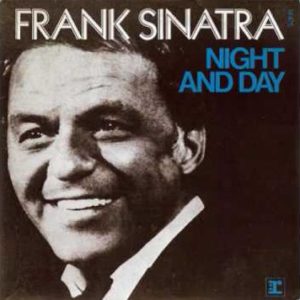In the opening chapters of his excellent music biography “Sinatra! The Song Is You,” veteran author Will Friedwald covers, with great detail, the evolution of Sinatra’s musical relationship with the Cole Porter jazz standard “Night and Day,” probably one of the most well-known sets of music and lyrics in the Sinatra singing canon. Listening to Sinatra’s 1957 recording of the tune today, which I played on repeat three times, enjoying the hell out of the arrangement, I was reminded of Friedwald’s painstakingly thorough dissection of this celebrated composition in reference to the Chairman of the Board, and it inspired me to take my own look at the old chestnut.
With the exception of perhaps “I’ve Got You Under My Skin,” another Cole Porter masterpiece, Sinatra perhaps got no more mileage greater out of a song then “Night and Day,” and proof of this is ample in the fact that he recorded the tune several times over the years across three record labels, each time offering up a new twist on the arrangement, and in some cases, even the lyrics. Here we look at the facts and figures behind seven different recordings of the song stemming from the 1940s to the 1980s, with Sinatra breathing new, and sometimes, unusual life into the mix each time.
The Columbia Recording (1942)
After breaking ties with bandleader Tommy Dorsey in the early 1940s, Columbia Records snatched up Frank with a solo performing contract that would see him recording his first sides as independent vocalist, and one of the four chosen sides was that of “Night and Day.” Arranged by early collaborator Axel Stordahl, it is perhaps the sweetest version of the piece. It has been said that hearing Sinatra sing this song in such a dramatic, longing, innocent way, is what had inspired Harry James to hire Sinatra to sing with his orchestra in 1939. Sinatra would record the song again in a similar arrangement by Stordahl in 1947. So popular is the original 1942 chart that, in his 1996 recorded bio-tribute to his father, “As I Remember It,” Sinatra’s son Frank JR. Included a truncated version of the arrangement as the opening piece to the musical program, serving as introduction to the spoken word history of Sinatra interspersed between the songs.
The Capitol Recording (“A Swingin’ Affair,” 1957)
Perhaps the best known orchestration of the song, the opening track from Capitol’s “A Swingin’ Affair” sees Nelson Riddle casting Sinatra into the midst of a maelstrom of rhythm and brass supplemented by sustained strings in one of the most swingin’ arrangements they ever collaborated on, on this, their fourth full album together. While “I’ve Got You Under My Skin” from their previous “Songs For Swingin’ Lovers” was the preeminent standout orchestration on that release, “Night and Day” stands as the proverbial sequel on this album. With stinging brass notes firing over rockin’ rhytmn on the drums provided by Alvin Stoller, the fun doesn’t let up, only calming on the bridge where a light trombone solo leads the sax section to build into a roar, with the brass section overtaking and eventually reaching its summit along with the singer, who holds the final “day” against the trumpets so long, you’re unsure if his voice is going to hold. It does. To quote author Chuck Granata, this album, along with its predecessor, is the “zenith” of the Capitol era.
The Reprise Recording (“Sinatra and Strings,” 1961)
After bringing the Riddle arrangement with him to concerts in the late 1950s/early 1960s (notably during a 1959 Australian concert held in West Melbourne), Sinatra decided to remake the song once again, returning to ballad form with one of his early release on his self-owned Reprise Records. Don Costa, long before he became Sinatra’s literal music director (and arranger of a wealth of kiddie pop for the drifting Chairman throughout the late 1960s ans 1970s), brought to his first collaboration with Sinatra a series of ten richly orchestrated ballad arrangements, “Night and Day” being the second selection on the album. The arrangement and performance recalls the younger, twenty-something Sinatra of years ago, but he puts an indelible stamp on this new version by showing the audience that his voice has reached full maturity. While we are dealing with the boy Sinatra in the Columbia version, the Reprise remake signals the arrival of a man.
The Combo Recording(s) (1962/1982)
While it wasn’t always exclusive, Sinatra’s work with smaller groups allowed the singer to branch out and tweak his style of phrasing and delivery. With the strings and brass absent, there was plenty of room for the singer to stretch his vocal cords to previously unconquerable heights. Such is the case when Sinatra took his sextet led by Bill Miller on the road for his globe-spanning 1962 World Tour. Whittled down from the classic Nelson Riddle arrangement, Sinatra performed the swing version of the tune for an early part of the tour (with the tempo a half beat faster) as well as during a commercial shooting for Baci candy (shot at RAI Studios) while the Sinatra contingent visited Italy, performing a truncated version. For the rest of the tour, Sinatra performed the tune as a very relaxed, dramatic duet with guitar (supplied by veteran Al Viola). One of these such duet performances took place during the Paris leg of the tour and was recorded along with the rest of the French concert. A pin drop can be heard in the quiet background during the performance, which is, simply remarkable.
Sinatra returned to the tune again during the 1980s. While he performed the original Riddle arrangement occasionally, a more interesting version featuring quintet was recorded during his Caesars’ Palace stay in March 1982, featured in an excellent recording on disc three of the 2006 box set “Sinatra: Vegas.” Once again, devoid of orchestral accompaniment, Frank has fun with the tune, twisting and bending phrases to the erratic rhythm of his core players, and holding the last “day” so long (like in ‘57) that he looks out in the audience and jokingly requests an oxygen tank.
The Disco Recording (1977)
Discussing this recording in front of a Sinatra fan often ends in sharpened eyes and curled lips. Many wonder what end result the Chairman was focusing on when he decided to cut two new versions of his hits “All Or Nothing At All” and “Night and Day” to the sound of funky disco arrangements created by Joe Beck in 1977. They make for, to say the least, an interesting listening experience. While there are live versions of the song that are a bit more enjoyable, featuring some cool brass from full orchestra (not used in the studio version), a majority of Sinatra fans feel that this was a mountain Frank was not destined to climb. Sinatra himself must have realized this, for at a rehearsal sometime after the release of the disco version, he called for the orchestra to go over the tune using the Beck arrangement. Immediately noticing grimaces among the musicians’ faces, he told them to get rid of it and pull the old Riddle arrangement back out.
A bit disheartening that, as much as Sinatra liked the tune, the two times that songwriter Porter himself was around to acknowledge Sinatra’s performances both ended with unpleasant situations. When Sinatra was about to perform for an audience in New Jersey in the late 1930s, he noticed Porter in attendance at the venue. Stepping to the stage, Sinatra acknowledged the songwriter from the microphone, and, in tribute to him, wanted to perform “Night and Day.” The musicians began to play, and when Sinatra opened his mouth to sing the words, was so overcome with jostled nerves that he forgot the lyrics.
The other instance was Cole Porter voicing his disapproval of Sinatra’s tweaking of the lyrics in his 1957 recording with Nelson Riddle. Porter was quoted as saying to sing the song as he wrote it, and not add any phrases or intonations. Sad considering it’s one of Sinatra’s finest and wildest performances behind the microphone, but at the same time, it’s safe to say it was a slight that Sinatra just dusted off. Another tidbit of brief notoriety emanating from the legend that was SINATRA.
Until next time, Sinatra lovers!
Jerry Pearce is an amateur singer in the vein of Frank Sinatra, Perry Como, and Dick Haymes and has released two discs of standards music, Crossroads in 2010, and One Summer Night in 2016. Samples of his music can be heard on his YouTube Channel. To purchase his CDs use the form box below.
[si-contact-form form=’3′]

 March 21st, 2017
March 21st, 2017  CEO
CEO 
 Posted in
Posted in  Tags:
Tags: 



